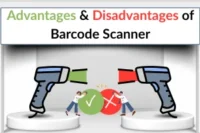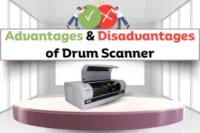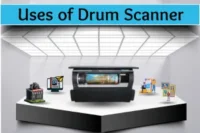Advantages and Disadvantages of Dot Matrix Printer (DMP): A Beginner’s Guide
Published: 26 May 2025
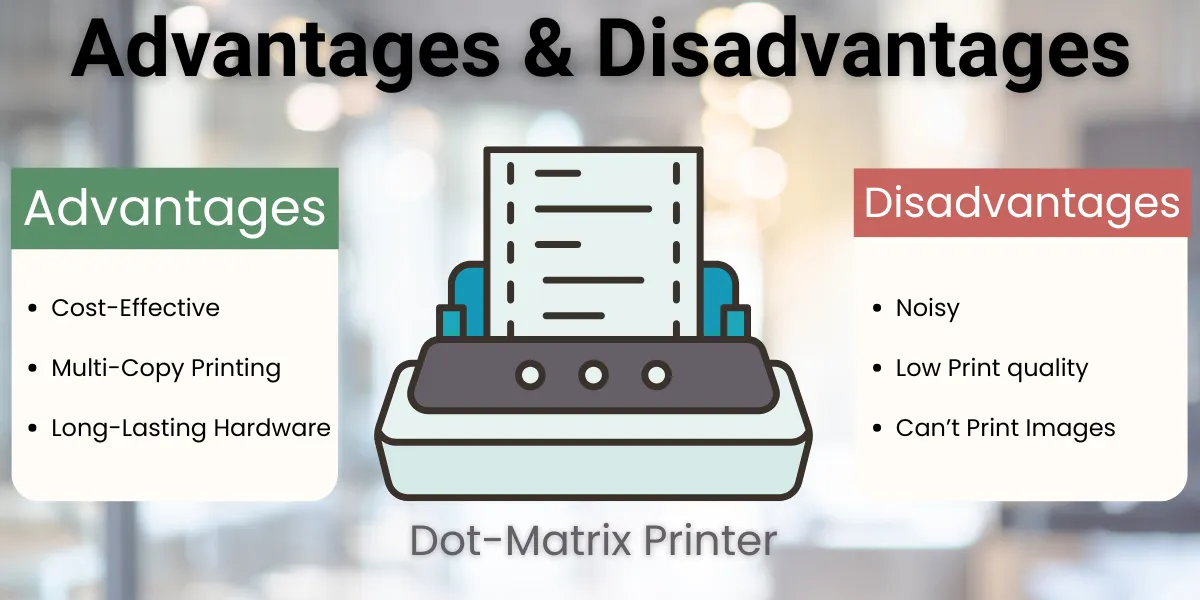
Hey Champs!
Curious about how printers worked before inkjet and laser printers?
Let me introduce you to the dot matrix printer, an old-style printer that prints using small pins and an ink ribbon. It’s like a typewriter that forms letters using tiny dots.
In this post, we’ll explore the advantages and disadvantages of dot matrix printer simply and clearly. You’ll learn where these printers are still useful today and why many people have stopped using them—with real-life examples even a beginner or a school going student can easily understand.
| What is a Dot Matrix Printer in Simple Words? – Simple Definition |
|---|
|
A dot matrix printer is an old-style impact printer that creates letters and images using tiny dots. It hits small pins on an ink ribbon, then strikes the paper like a typewriter. These printers are mostly used where multiple copies are needed at once, such as railway ticket counters or bank receipts. |
Top 10 Advantages of Dot Matrix Printer (DMP)
Even though dot matrix printers are old, some businesses still prefer them. Why? Because they are reliable, low-cost, and ideal for specific tasks like bulk receipts or invoices.
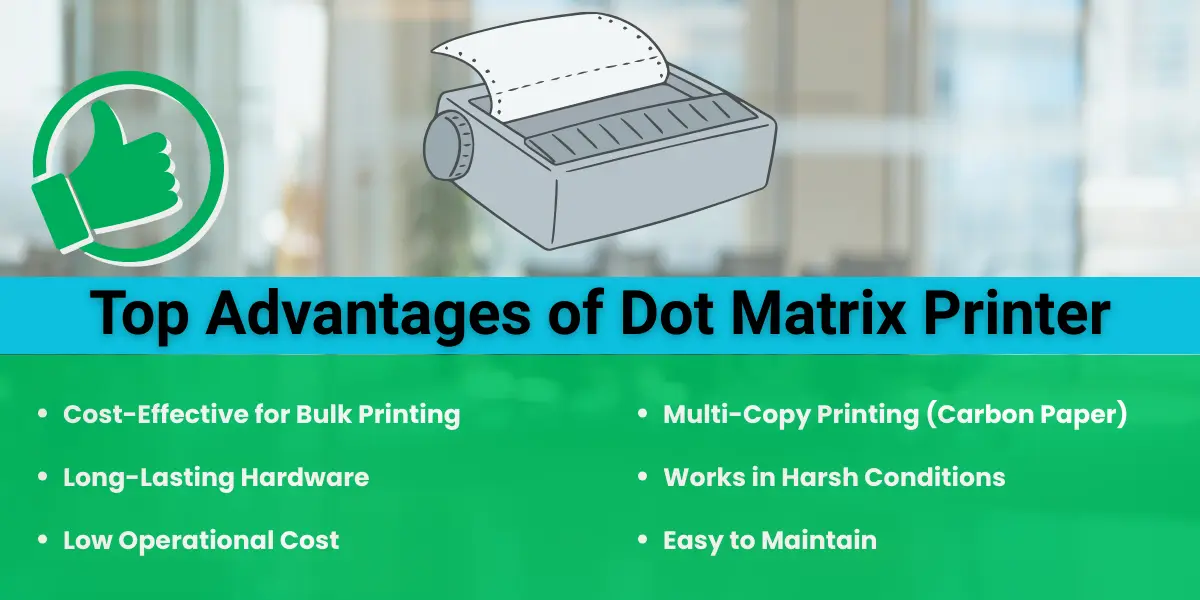
Here is quick list of pros of dot matrix printer:
- Cost-Effective for Bulk Printing
- Long-Lasting Hardware
- Low Operational Cost
- Multi-Copy Printing (Carbon Paper)
- Works in Harsh Conditions
- Minimal Software Need
- Easy to Maintain
- Continuous Paper Support
- Simple Mechanical Design
- Great for Fixed Layout Jobs
Let’s explore the above-mentioned benefits of dot matrix printers with real-life examples in simple words.
1. Cost-Effective for Bulk Printing
Dot matrix printers are perfect for printing large volumes without spending too much on ink or toner. Offices that need thousands of receipts or reports daily still rely on them.
Example: Ideal for government departments printing monthly statements.
2. Long-Lasting Hardware
These printers are tough and built to last for years. Unlike modern printers, they don’t break easily and can work for long hours without issues.
Example: Some banks still use the same dot matrix printers installed 10+ years ago.
3. Low Operational Cost
You don’t need costly cartridges—just ribbon and paper, which are much cheaper than laser or inkjet supplies.
Example: Local transport offices save money using dot matrix printers for ticket printing.
4. Multi-Copy Printing (Carbon Paper)
Dot matrix printers can print multiple copies at once using carbon paper—something modern printers can’t do.
Example: Delivery companies print three copies at once—one for the customer, one for the driver, and one for the office.
5. Works in Harsh Conditions
These printers can work in dusty or hot places where modern printers might fail.
Example: Factories or outdoor booths use them because they don’t stop working in rough environments.
6. Minimal Software Need
Dot matrix printers don’t need advanced drivers or software. They just plug in and work with basic settings.
Example: Small offices with old computers can still use these printers easily.
7. Easy to Maintain
Their simple mechanical parts make repairs quick and cheap. No complex electronics to deal with.
Example: Office staff can often fix basic issues without calling a technician.
8. Continuous Paper Support
Dot matrix printers work smoothly with continuous paper rolls, which is great for printing long reports or invoices.
Example: Billing systems in petrol pumps or retail shops still use continuous forms.
9. Simple Mechanical Design
The design is basic, so fewer things go wrong. This makes it ideal for places where reliability is more important than looks.
Example: Warehouse offices that don’t need fancy printing still rely on dot matrix machines.
10. Great for Fixed Layout Jobs
Dot matrix printers are perfect if you regularly print the same type of forms or documents. Just load the form and hit print.
Example: Utility companies use them for monthly electricity bills with fixed layouts.
As you can see, dot matrix printers still offer unique advantages for specific needs, especially when cost and reliability matter most.
Top 10 Disadvantages of Dot Matrix Printer (DMP)
Wondering why dot matrix printers are rarely seen today? While they offer some benefits, they also have serious downsides.
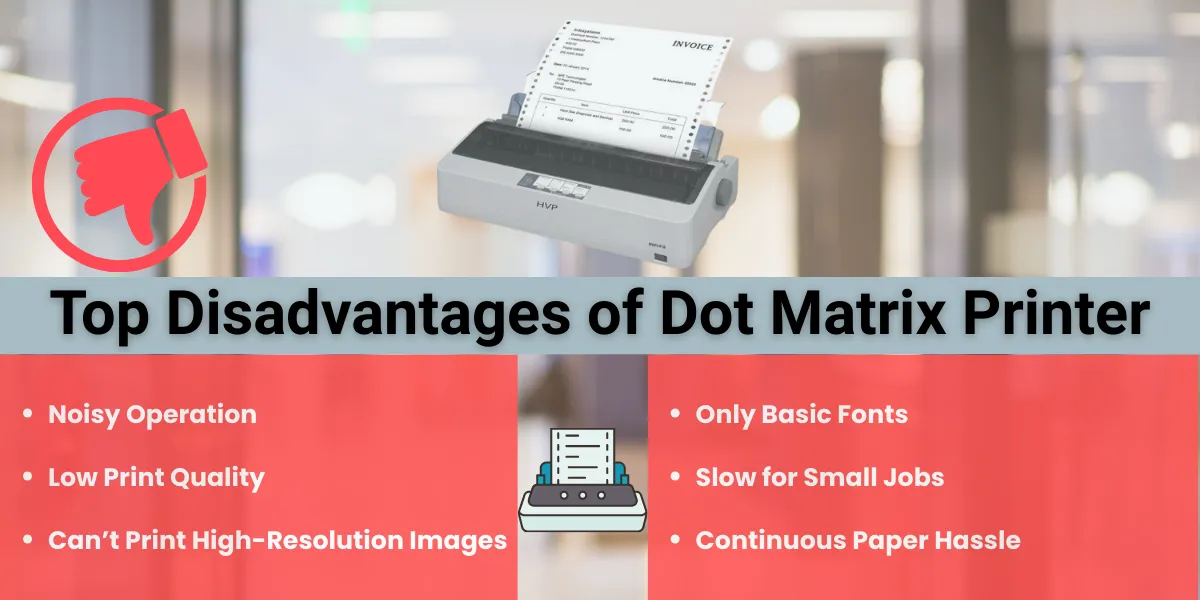
Here is quick list of drawbacks of dot matrix printers:
- Noisy Operation
- Low Print Quality
- Can’t Print High-Resolution Images
- Only Basic Fonts
- Slow for Small Jobs
- Continuous Paper Hassle
- Expensive Initial Cost
- Mechanical Parts Wear Faster
- Not Eco-Friendly
- Outdated for Modern Needs
Let’s explore these key disadvantages with real-world examples.
1. Noisy Operation
Dot matrix printers make a loud “chattering” sound while printing. This noise can be disturbing in quiet environments like libraries or small offices.
Example: A dot matrix printer running during a client meeting can feel unprofessional and distracting.
2. Low Print Quality
These printers can’t produce sharp or clean text like inkjet or laser printers. The output often looks faint or uneven.
Example: School report cards printed with dot matrix may look unclear or dull compared to modern prints.
3. Can’t Print High-Resolution Images
Dot matrix printers are not designed for photo printing or detailed graphics. They only print using tiny dots in simple patterns.
Example: Businesses needing to print logos or ID photos won’t get good results.
4. Only Basic Fonts
The font options are limited. You can’t easily use stylish or creative fonts, which reduces design flexibility.
Example: Invoices or letters lack modern formatting, making them look outdated.
5. Slow for Small Jobs
Although they are okay for bulk printing, they’re slow when printing just one or two pages.
Example: Printing a single receipt can take several seconds, which adds up during peak hours.
6. Continuous Paper Hassle
Dot matrix printers use perforated, continuous paper that needs proper alignment. Paper jams and tearing are common.
Example: If alignment goes off, you waste paper and time fixing the setup.
7. Expensive Initial Cost
Even though running costs are low, buying a new dot matrix printer can be more expensive than entry-level inkjets.
Example: A small business on a budget may prefer cheaper, modern printers with better features.
8. Mechanical Parts Wear Faster
Since they work by physically striking the paper, parts like print heads and ribbons wear out quickly and need regular replacement.
Example: Frequent maintenance may cost more over time than expected.
9. Not Eco-Friendly
The ribbons and carbon paper used in these printers add to waste. Plus, energy use is generally higher than that of modern, efficient models.
Example: Offices focused on sustainability avoid using dot matrix printers today.
10. Outdated for Modern Needs
They lack USB support, wireless printing, and color printing, and they are not compatible with many modern apps or systems.
Example: You can’t easily connect a dot matrix printer to cloud services like Google Drive or mobile printing apps.
Real-World Limitation: A travel agency tried using a dot matrix printer for flight tickets but had to switch to a laser printer because customers found the prints hard to read and unappealing.
Now that you’ve seen both sides i.e. pros and cons of dot matrix printers, you can better understand when a dot matrix printer makes sense—and when it doesn’t.
Comparison Table – Pros vs Cons of Dot Matrix Printer
Here’s a simple comparison to quickly understand the advantages and disadvantages of dot matrix printer in one glance:
Advantages | Disadvantages |
Cost-effective for bulk printing | Noisy operation |
Durable and long-lasting | Low print quality |
Low running cost | Can’t print high-resolution images |
Prints multiple copies at once (carbon) | Limited font options |
Works in dusty or harsh environments | Slow for small jobs |
Minimal software requirements | Paper alignment issues |
Easy to maintain | Higher initial cost |
Supports continuous paper rolls | Moving parts wear out faster |
Simple mechanical design | Not eco-friendly (uses ribbons, more power) |
Ideal for fixed-format printing tasks | Lacks modern features (USB, wireless, etc) |
Are Dot Matrix Printers Still Used Today?
Yes, dot matrix printers are still used in a few specific areas. Even though modern printers are faster and quieter, they are preferred where durability and multi-copy printing are important.
You’ll often find them in banks, government offices, and industrial setups. For example, Indian Railways still uses dot matrix printers to print train tickets. Similarly, many warehouses and invoice billing systems use them to create carbon copy documents quickly.
These printers may be old, but they still serve a useful purpose where rugged use and continuous printing are needed.
| Key Takeaways (Quick Summary) |
|---|
|
Here’s a quick look at the 5 most common advantages and disadvantages of dot matrix printers: Top 5 Main Advantages
Top 5 Main Disadvantages
|
Final Thoughts
So champs, I’m going to conclude the topic of advantages and disadvantages of dot matrix printers. Knowing both sides of these printers helps us understand how far printing technology has come.
Although they’re still useful in places like banks or railways, most people today prefer faster and sharper options like inkjet or laser printers. If you’re a student exploring computer basics, don’t stop here—check out other types of printers too!
Found this helpful? Share it with your classmates!
FAQs – Students Often Ask
Students often have these common questions about dot matrix printers—let’s clear them up one by one.
Dot matrix printers are commonly used for printing multi-copy forms, invoices, receipts, and tickets. They are still popular in retail, banking, and transportation industries, where continuous paper and carbon copies are needed.
No, dot matrix printers typically print in black and white. They are designed for text-based printing and do not support high-quality color printing like inkjet or laser printers.
Dot matrix printers are noisy because they use a print head with pins that strike an inked ribbon onto the paper. The impact of these pins creates a loud clattering sound during printing.
In 2025, dot matrix printers will be mainly useful in specific industries that require durable, multi-copy printouts. Modern printers like inkjets or lasers will be more efficient for general home or office use.
Dot matrix printers are known for their durability. With proper maintenance, they can last many years, making them a great option for businesses needing reliable, long-lasting printing solutions.
The main disadvantages are low print quality, noisy operation, and the inability to print high-resolution images. They also require continuous paper, which can be messy and inconvenient.
Yes, dot matrix printers excel at handling high-volume printing tasks. They are ideal for quickly printing large quantities of text-based documents, such as in warehouses or for financial reports.
Dot matrix printers are slower and have lower print quality than laser printers. However, they are more durable and cost-effective for printing in bulk and handling multi-copy jobs, especially in harsh environments.
Yes, dot matrix printers are generally easy to maintain. They have fewer complex parts, and users can perform basic servicing, like replacing ribbons and cleaning the print head, without professional help.
Dot matrix printers are used in situations requiring durability and multi-copy printing. Common applications include:
- Invoices & receipts: Used in retail and finance for multi-copy printing.
- Ticket printing: Found in transportation for travel tickets.
- Forms & documents: Used in banks and hospitals for forms.
- Barcode labels: Printed in warehouses for shipping labels.
- Industrial use: Common in factories for label printing.
- Low Printing Cost: Dot matrix printers use inexpensive ink ribbons, making them budget-friendly for regular printing.
- Multi-Copy Printing: They can print multiple copies using carbon paper, which is ideal for receipts and forms.

- Be Respectful
- Stay Relevant
- Stay Positive
- True Feedback
- Encourage Discussion
- Avoid Spamming
- No Fake News
- Don't Copy-Paste
- No Personal Attacks

- Be Respectful
- Stay Relevant
- Stay Positive
- True Feedback
- Encourage Discussion
- Avoid Spamming
- No Fake News
- Don't Copy-Paste
- No Personal Attacks
